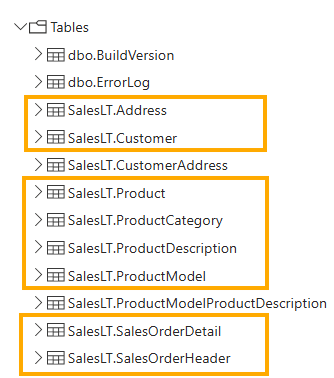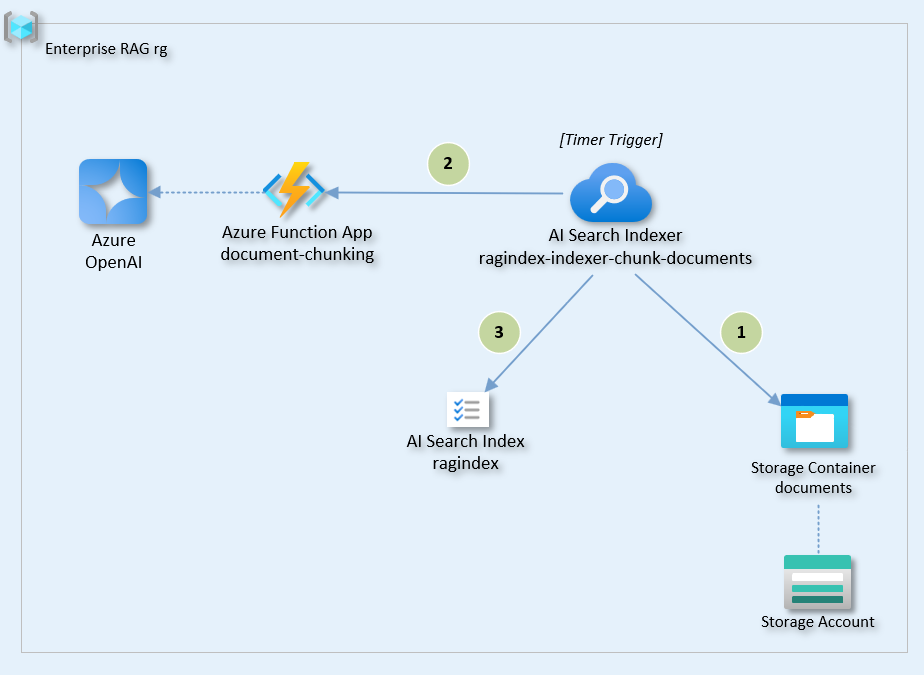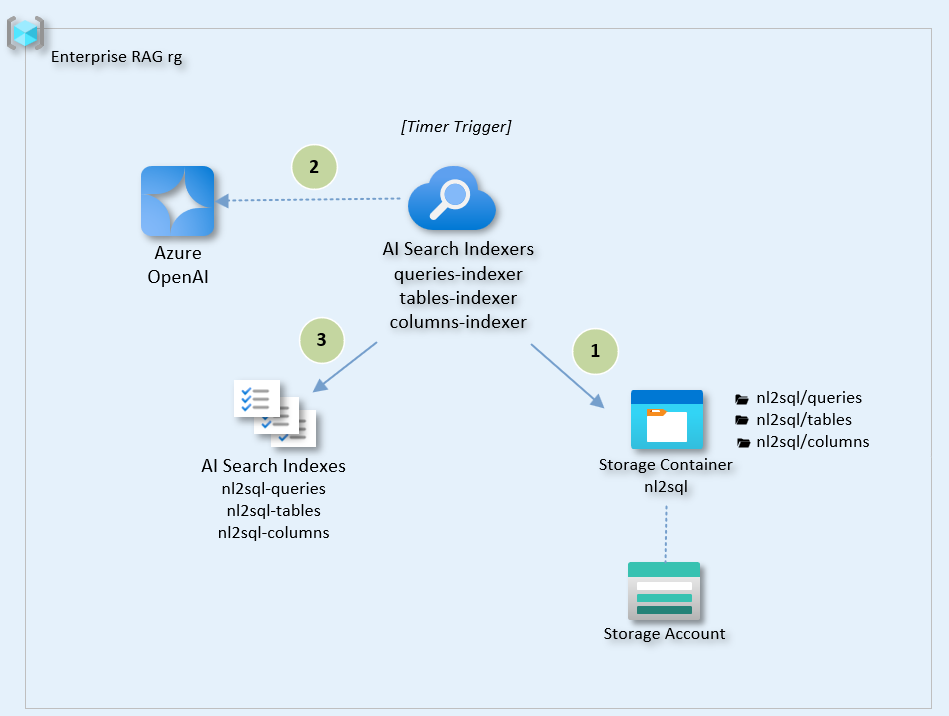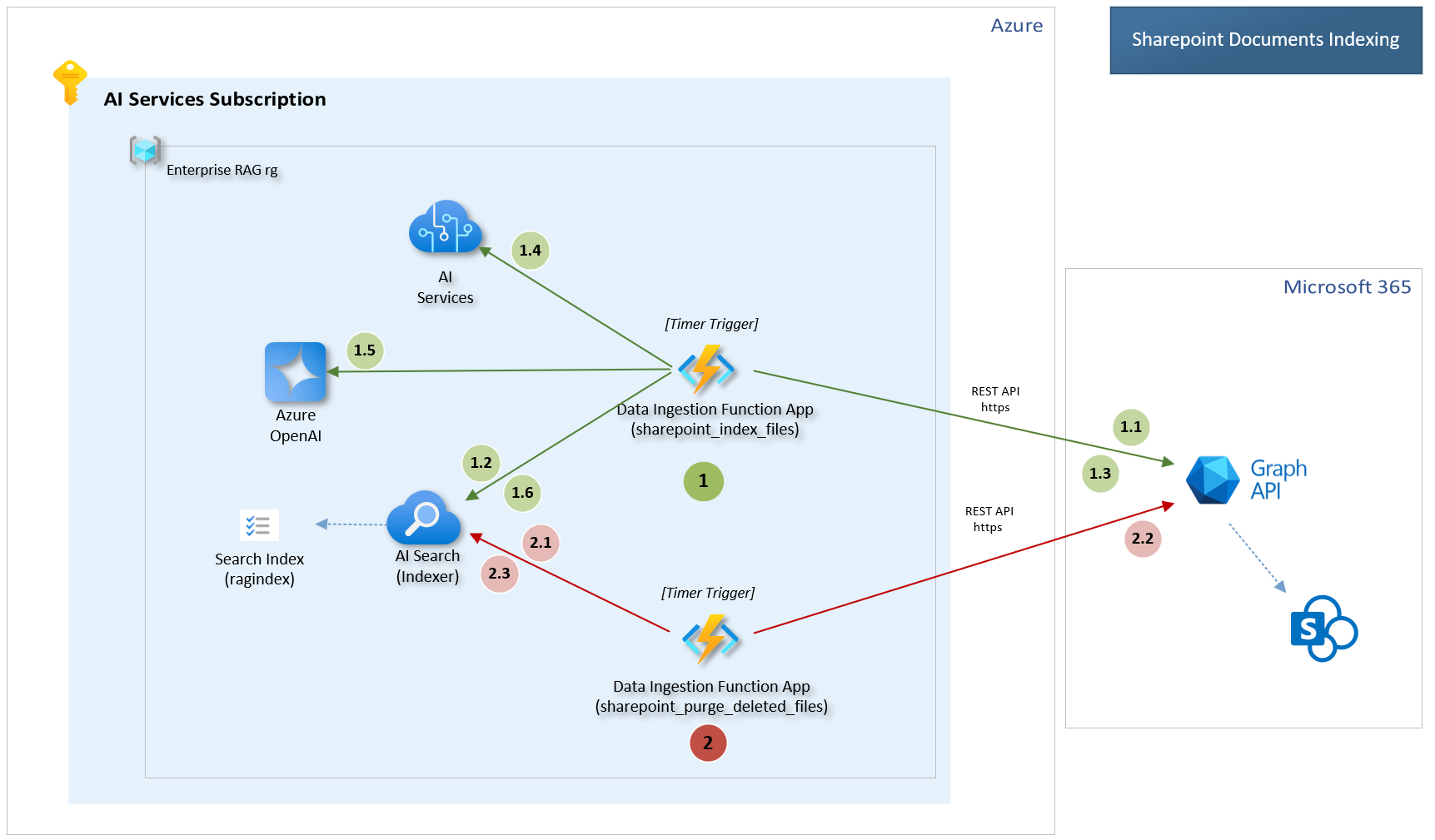Part of GPT-RAG
The diagram below provides an overview of the document ingestion pipeline, which handles various document types, preparing them for indexing and retrieval.
Workflow
-
The
ragindex-indexer-chunk-documentsindexer reads new documents from thedocumentsblob container. -
For each document, it calls the
document-chunkingfunction app to segment the content into chunks and generate embeddings using the ADA model. -
Finally, each chunk is indexed in the AI Search Index.
The document_chunking function breaks documents into smaller segments called chunks.
When a document is submitted, the system identifies its file type and selects the appropriate chunker to divide it into chunks suitable for that specific type.
-
For
.pdffiles, the system uses the DocAnalysisChunker with the Document Intelligence API, which extracts structured elements, like tables and sections, converting them into Markdown. LangChain splitters then segment the content based on sections. When Document Intelligence API 4.0 is enabled,.docxand.pptxfiles are processed with this chunker as well. -
For image files such as
.bmp,.png,.jpeg, and.tiff, the DocAnalysisChunker performs Optical Character Recognition (OCR) to extract text before chunking. -
For specialized formats, specific chunkers are applied:
.vttfiles (video transcriptions) are handled by the TranscriptionChunker, chunking content by time codes..xlsxfiles (spreadsheets) are processed by the SpreadsheetChunker, chunking by rows or sheets.
-
For text-based files like
.txt,.md,.json, and.csv, the LangChainChunker uses LangChain splitters to divide the content by paragraphs or sections.
This setup ensures each document is processed by the most suitable chunker, leading to efficient and accurate chunking.
Important: The file extension determines the choice of chunker as outlined above.
Customization
The chunking process is customizable. You can modify existing chunkers or create new ones to meet specific data processing needs, optimizing the pipeline.
If you are using the few-shot or few-shot scaled NL2SQL strategies in your orchestration component, you may want to index NL2SQL content for use during the retrieval step. The idea is that this content will aid in SQL query creation with these strategies. More details about these NL2SQL strategies can be found in the orchestrator repository.
The NL2SQL Ingestion Process indexes three content types:
- query: Examples of queries for both few-shot and few-shot scaled strategies.
- table: Descriptions of tables for the few-shot scaled scenario.
- column: Descriptions of columns for the few-shot scaled scenario.
Note
If you are using the few-shot strategy, you will only need to index queries.
Each item—whether a query, table, or column—is represented in a JSON file with information specific to the query, table, or column, respectively.
Here’s an example of a query file:
{
"question": "What are the top 5 most expensive products currently available for sale?",
"query": "SELECT TOP 5 ProductID, Name, ListPrice FROM SalesLT.Product WHERE SellEndDate IS NULL ORDER BY ListPrice DESC",
"selected_tables": [
"SalesLT.Product"
],
"selected_columns": [
"SalesLT.Product-ProductID",
"SalesLT.Product-Name",
"SalesLT.Product-ListPrice",
"SalesLT.Product-SellEndDate"
],
"reasoning": "This query retrieves the top 5 products with the highest selling prices that are currently available for sale. It uses the SalesLT.Product table, selects relevant columns, and filters out products that are no longer available by checking that SellEndDate is NULL."
}In the nl2sql directory of this repository, you can find additional examples of queries, tables, and columns for the following Adventure Works sample SQL Database tables.

Sample Adventure Works Database Tables
Note
You can deploy this sample database in your Azure SQL Database.
The diagram below illustrates the NL2SQL data ingestion pipeline.
Workflow
This outlines the ingestion workflow for query elements.
Note:
The workflow for tables and columns is similar; just replace queries with tables or columns in the steps below.
-
The AI Search
queries-indexerscans for new query files (each containing a single query) within thequeriesfolder in thenl2sqlstorage container.Note:
Files are stored in thequeriesfolder, not in the root of thenl2sqlcontainer. This setup also applies totablesandcolumns. -
The
queries-indexerthen uses the#Microsoft.Skills.Text.AzureOpenAIEmbeddingSkillto create a vectorized representation of the question text using the Azure OpenAI Embeddings model.Note:
For query items, the question itself is vectorized. For tables and columns, their descriptions are vectorized. -
Finally, the indexed content is added to the
nl2sql-queriesindex.
The SharePoint connector operates through two primary processes, cada um deles roda em uma function da Data Ingestion Function App:
- Indexing SharePoint Files:
sharepoint_index_filesfunction retrieves files from SharePoint, processes them, and indexes their content into the Azure AI Search Index (ragindex). - Purging Deleted Files:
sharepoint_purge_deleted_filesidentifies and removes files that have been deleted from SharePoint to keep the search index up-to-date.
Both processes are managed by scheduled Azure Functions that run at regular intervals, leveraging configuration settings to determine their behavior. The diagram below illustrates the Sharepoint indexing.
Workflow
1.1. List files from a specific SharePoint site, directory, and file types configured in the settings.
1.2. Check if the document exists in the AI Search Index. If it exists, compare the metadata_storage_last_modified field to determine if the file has been updated.
1.3. Use the Microsoft Graph API to download the file if it is new or has been updated.
1.4. Process the file content using the regular document chunking process. For specific formats, like PDFs, use Document Intelligence.
1.5. Use Azure OpenAI to generate embeddings for the document chunks.
1.6. Upload the processed document chunks, metadata, and embeddings into the Azure AI Search Index.
2.1. Connect to the Azure AI Search Index to identify indexed documents.
2.2. Query the Microsoft Graph API to verify the existence of corresponding files in SharePoint.
2.3. Remove entries in the Azure AI Search Index for files that no longer exist.
Azure Function triggers automate the indexing and purging processes. Indexing runs at regular intervals to ingest updated SharePoint files, while purging removes deleted files to maintain an accurate search index. By default, both processes run every 10 minutes when enabled.
If you'd like to learn how to set up the SharePoint connector, check out SharePoint Connector Setup.
-
Provision the infrastructure and deploy the solution using the GPT-RAG template.
-
Redeployment Steps:
- Prerequisites:
- Azure Developer CLI
- PowerShell (Windows only)
- Git
- Python 3.11
- Redeployment commands:
azd auth login azd env refresh azd deploy
Note: Use the same environment name, subscription, and region as the initial deployment when running
azd env refresh.
- Prerequisites:
- Instructions for testing the data ingestion component locally using in VS Code. See Local Deployment Guide.
Follow the instructions to configure the SharePoint Connector in the Configuration Guide: SharePoint Connector.
- Refer to the GPT-RAG Admin & User Guide for instructions.
- See GPT-RAG Admin & User Guide for reindexing instructions.
Here are the formats supported by each chunker. The file extension determines which chunker is used.
| Extension | Doc Int API Version |
|---|---|
| 3.1, 4.0 | |
| bmp | 3.1, 4.0 |
| jpeg | 3.1, 4.0 |
| png | 3.1, 4.0 |
| tiff | 3.1, 4.0 |
| xlsx | 4.0 |
| docx | 4.0 |
| pptx | 4.0 |
| Extension | Format |
|---|---|
| md | Markdown document |
| txt | Plain text file |
| html | HTML document |
| shtml | Server-side HTML document |
| htm | HTML document |
| py | Python script |
| json | JSON data file |
| csv | Comma-separated values file |
| xml | XML data file |
| Extension | Format |
|---|---|
| vtt | Video transcription |
| Extension | Format |
|---|---|
| xlsx | Spreadsheet |


